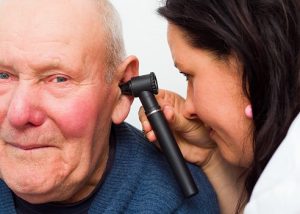
How a ruptured eardrum affects hearing loss?
A perforated eardrum can cause some hearing loss that is dependent on the size of the hole or tear. The larger the hole, the more hearing loss experienced. Chronic ear infection due to the perforation can cause sustained hearing loss and tinnitus.
Ruptured eardrum signs and symptoms
Symptoms that may indicate a ruptured eardrum include an earache or pain that ebbs quickly, clear, pus-filled, or bloody secretion from the ear, hearing loss, tinnitus, vertigo, nausea, or vomiting.
What causes a ruptured eardrum?
A ruptured eardrum may be caused by:
Middle ear infection. These infections can result in the accumulation of fluid in the middle ear that creates pressure and can cause holes and tears.
Barotrauma. Caused by an imbalance of pressure within the middle ear and air pressure outside, barotrauma can cause ruptures especially during air travel and scuba diving – activities where barometric pressure changes quickly.
Loud sounds. Loud noises like gunshots and explosions can cause overpowering soundwaves that can perforate the eardrum.
Foreign objects. Inserting an object too far into your ear—such as a cotton swab—can puncture the eardrum.
Head trauma. A severe head injury such as a fracture to the skull can cause damage to the structure of the inner and middle ear, including the eardrum.
Complications of ruptured eardrum
If you rupture your eardrum, complications such as hearing loss and lessened protection of the middle ear can occur. The hearing loss may vary based on the size of the tear, while the hole in the eardrum can allow dirt and water to pass through into the middle ear causing infection. You may also develop a middle ear cyst made up of skin debris and wax that can promote bacteria growth and cause further infection.
Ruptured eardrum diagnosis
A ruptured eardrum is usually diagnosed using a variety of tests, including a lab test of any ear discharge, a tuning fork evaluation to assess hearing loss, an audiology exam to measure how well you can hear regulated sounds within a soundproof environment, as well as a tympanometry test to examine your eardrum’s response to changes in air pressure.
Ruptured eardrum (perforated eardrum) treatment options
Depending on the severity of your condition, you doctor may choose to monitor the perforation and allow it to heal on its own. However, in some cases, your physician may encourage tissue growth by swabbing the edges of the tear with a chemical to stimulate growth, then place a thin paper patch over the hole while it heals. Surgery may be required if the hole is large enough that a patch will not be sufficient.
Ruptured eardrum (perforated eardrum) prevention tips
To prevent a perforated eardrum, ensure that you always get treatment for inner ear infections so that fluid cannot build up and put pressure on the thin tissue. Also, take care to protect your ears when flying by using pressure-equalizing earplugs or yawning and swallowing to keep the ear canal open. Be sure to keep objects out of your ears and only use cotton swabs to clean the outer shell of the ear, as they can slip and cause a tear. Finally, guard your ears against excessive noise by using ear plugs when operating loud machinery or attending an event with an excessive noise like a car race or concert.
When to see a doctor for a ruptured eardrum?
You may need to visit your doctor if your symptoms persist or the hearing loss is proving to be detrimental. Your doctor will be able to evaluate the damage to your eardrum and may recommend either a paper patch or surgery in order to help it heal faster.
A ruptured or perforated eardrum is a hole or tear in the eardrum that may be caused by an ear infection, trauma, an imbalance in pressure, or a foreign object. This condition may cause temporary hearing loss and pain as well as secretion of blood, mucus or pus. Your doctor can diagnose the severity of your condition, and based upon this will suggest a treatment option.
Related: Common hearing problem improved with music